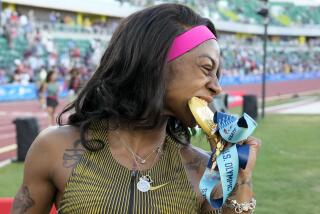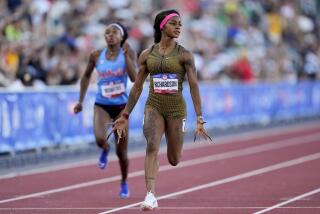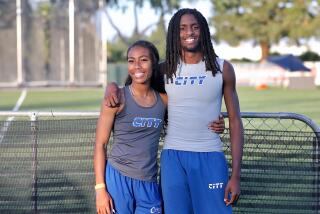Fame Not the Name of Pile’s Game : Track and field: In Division II championships, the CSUN senior will triple jump for fun, not glory.
HAMPTON, Va. — A tip for those who want to become famous in track and field: In any event, don’t specialize in just any event.
The 100-meter dash, the mile--or its metric counterpart, the 1,500--and the men’s 110-meter high hurdles receive good coverage in the news media, if there is such a thing as good track coverage in the United States.
The men’s hammer throw or the women’s discus, on the other hand, are events in which the participants rarely get publicity, unless they set a record.
In some ways, the women’s triple jump is even lower on the track-and-field totem pole because it is not yet an Olympic event. But that doesn’t bother Cal State Northridge senior Lolita Pile, who will compete in that event, as well as the long jump and the 400-meter relay, in the NCAA Division II championships, today through Saturday at Hampton University.
“(The triple jump) is not one of those fame events,” said Pile, who holds the Northridge record at 42 feet 1 1/4 inches and jumped a wind-aided 42-4 3/4 in last year’s Division II meet. “Some people compete for fame and glory. I triple jump because it feels good.
“When I jump well, I know it. It’s like when you take a test in school. You study hard getting ready for the test. And then you take it. And if you ace it, and you know it, it feels great.”
Based on her record, she has experienced good sensations aplenty at Northridge.
Pile is a three-time Division II All-American and a four-time California Collegiate Athletic Assn. champion who has improved her best in the triple jump every year since she started jumping in 1985.
She placed eighth in the Division II meet as a freshman in 1987, fourth in 1988, and second last year.
If she places among the top eight in the triple jump final Saturday, she will become the first Lady Matador to have earned Division II All-American track honors four consecutive years.
“She just has great athleticism,” said Northridge assistant Tony Veney, who coaches Pile. “When she first came here, she destroyed all the freshman (agility) records. In the vertical leap, in the standing broad jump, everything. . . . She could have excelled in several sports. She could have done very well in basketball or volleyball too.”
Although Veney is one of Pile’s biggest supporters now, it was Northridge Coach Don Strametz who told him about her when she was a senior at Sacramento’s Highlands High in 1986.
“Don said she was a prototype jumper,” Veney said. “And once I saw her, I knew he was right. She had the long legs, and though she was just a tiny little thing, it was obvious that she would develop.”
After arriving at Northridge as a 5-foot-4, 98-pound jump specialist with a personal best of 39-4, Pile improved to 39-8 3/4 in 1987, 40-8 1/4 in 1988 and 42-4 3/4 last year.
She jumped a wind-aided 42-3 1/2 in the Northridge Open on May 5 and Veney figures she is ready to bound past that mark.
“We were thinking 13.30 (meters, 43-7 3/4) or at least 13.00 (42-8) at the start of the season,” Veney said, “and I think she is fully capable of reaching that in the next few weeks. . . . Her 200 times have really started to come down in the last month. And when that happens, she usually improves in the triple jump.”
Pile will have to improve if she wants to dethrone Diana Wills of the U.S. Military Academy, the two-time defending Division II champion.
Wills was ranked third in the nation last year and has increased her personal best to 43-9 1/4, but Veney feels that she is beatable.
“Lolita can compete with this girl,” Veney said. “She’s always loose when she competes against her. She doesn’t let big-name people rattle her.”
Pile, who at 5-4 and 115 pounds is dwarfed by the 5-10, 130-pound Wills, is looking forward to the challenge.
“She really pushes me. I’m grateful for her,” Pile said. “I’ve always jumped well against her. . . . I would love to beat her. You always want to be called the best in something, but I’ll be happy as long as I jump well.”
Veney bases much of his optimism on Pile’s increased strength and improved knowledge of the event.
Although she does not spend as much time in the weight room as she should, Pile is a more powerful jumper this season.
“Last year, she stuck her leg out and ground would rush up to hit her,” Veney said. “This year, she’s taking a bite out of the ground.”
Because she has exceeded the Division I qualifying standard, Pile will be eligible to compete in the NCAA championships in Durham, N.C., May 30-June 2, if she finishes in the top two at Hampton.
Sixth on the U. S.-performer list last season, Pile was not ranked among the country’s top 10 by Track & Field News because she did not compete in the Division I or The Athletics Congress meets.
“She was just physically worn out at the end of last season,” Veney explained of Pile’s decision to bypass the meets. “She’s jumped in fewer meets this season and it’s helped.”
Pile also has focused more on the long jump and the sprints.
Sporting a best of 19-3 in the long jump at the start of the year, Pile has improved to 20-3, and she is running the second leg on the Lady Matadors’ 400 relay as fast as ever.
“Concentrating on the other events probably hurt her some in the triple jump early in the season,” Veney said. “Her technique wasn’t all there. She went to meets thinking she was going to jump farther than she did.
“But she didn’t panic. She knew enough to know the big jumps would come.”
Keeping her composure under the stress of competition is Pile’s biggest asset, according to Veney, but Pile says she could make her greatest improvements in her mental approach and in the weight room.
“I concentrate a little bit too much,” Pile said. “I get a little too serious and start getting frustrated when things aren’t going perfectly. Sometimes, I just need to relax more. After all, you’re out there to have fun.”
While Pile’s talents on the track and in the field will no doubt be missed on Northridge’s team next season, Veney says her quiet, unassuming, leadership also will be difficult to replace.
“She leads by example,” Veney said. “In a day and age where people feel they have to be vulgar and overly aggressive to command attention, she commands attention with the strength of her personality. . . . She has a very, very powerful spiritual upbringing and it shows. She has a very good image of herself.”
When informed of Veney’s comments, Pile reacted in embarrassment, then attributed the characteristics he described to her being the third of nine children.
“There’s not much room for selfishness and individualism when you have eight brothers and sisters,” she said with a laugh. “You learn early that you’re not always going to get your way.”
A year shy of earning a degree in liberal studies, Pile is unsure about her athletic future.
She would like to continue jumping, but she wants to start teaching after she graduates.
“I’ll probably let my body tell me when it’s time to stop,” Pile said. “I’d like to keep jumping because I don’t think I’ve come close to my best.”
Much could depend on how she fares next year.
The World Championships will be held in Tokyo, and, for the first time, the triple jump will be included in the women’s events.
The top three finishers in the 1991 TAC meet will qualify for the U.S. team, and Veney figures his protege has a legitimate shot at making the team.
“(U.S. record-holder Sheila) Hudson is a given,” Veney said. “But I think a 44-foot jump in the trials could make the team. I really feel Lolita could do that with improved training.”
But for now, Pile is focused on the Division II meet, and in particular, the triple jump.
“That’s my A No. 1 event,” she said. “I want to do well in the other events, but if if I do well in the long jump and the relay but don’t do good in the triple jump, I’d be upset.”
More to Read
Go beyond the scoreboard
Get the latest on L.A.'s teams in the daily Sports Report newsletter.
You may occasionally receive promotional content from the Los Angeles Times.










